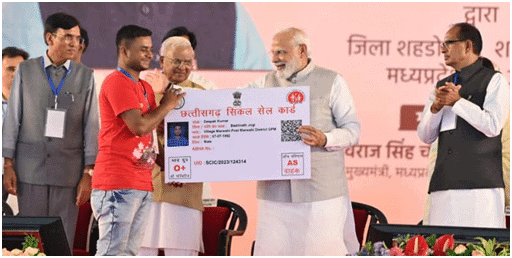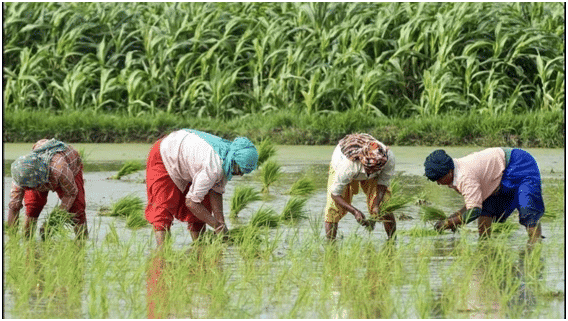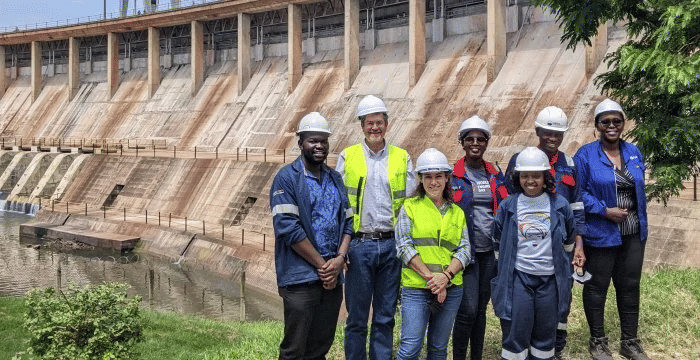Yojana Summary: December 2024 | Current Affairs & Hindu Analysis: Daily, Weekly & Monthly - UPSC PDF Download
India’s Emergence As A Hub Of Knowledge and Technology

India’s technological advancements drive its economic growth, aiming for a 5 trillion USD GDP by 2025. Key achievements include the Green and White Revolutions, atomic energy, space, and pharmaceutical progress.
- The country is focusing on self-reliance, which has led to local solutions and an increase in renewable energy.
- Programs such as Digital India, Startup India, and UPI payments demonstrate India's dedication to inclusive, technology-based development.
- This commitment is helping India position itself as a global economic leader.
- India is ranked fifth in terms of nominal GDP and third when considering purchasing power parity.
Technology As A National Priority
Landscape of Science and Technology in India
- India has made science and technology (S&T) a top priority to tackle major issues such as climate change, clean energy, and healthcare.
The country is showing its commitment by increasing investment in research and development (R&D), with the Gross Expenditure on R&D (GERD) reaching Rs 1,27,380.96 crores in the year 2020-21. - The private sector now plays a significant role, contributing 36.4% to the GERD, especially in areas like pharmaceuticals, information technology (IT), and textiles.
- India's scientific research output has increased dramatically, with the number of publications growing 2.5 times from 2010 to 2020.
- This growth has helped position India as a global leader in important fields such as computer science, engineering, and health sciences.
Innovation Ecosystem
- India has improved its position in the Global Innovation Index (GII), moving up to 39th place in 2024 from 81st in 2015. This change shows that India is focusing more on innovation.
- The country now boasts over 100 unicorns and has launched several initiatives such as Startup India, Atal Innovation Mission (AIM), and Atmanirbhar Bharat, making it a center for global innovation.
- AIM offers various programs, including Atal Tinkering Labs (ATLs) and Atal Incubation Centres (AICs), which provide students and startups with practical experience and funding.
- AIM’s projects, like the Atal New India Challenge, help to create a lively startup ecosystem and ensure that India’s innovation efforts meet global standards.
Economic Impact of Technology
- Technology is changing important parts of India’s economy, such as agriculture, healthcare, manufacturing, and mobility.
- In agriculture, new methods like precision farming and AI-based crop monitoring are helping to increase productivity.
- In healthcare, digital tools like telemedicine and AI-driven diagnostics are making services better, especially for people in rural areas.
- The manufacturing industry is gaining from Industry 4.0 technologies, with programs like ‘Make in India’ attracting investments and making India a global center.
- The digital economy is expanding quickly due to 5G, AI, and IoT, changing areas like smart cities, transportation, and finance.
- India is moving towards translational research, which speeds up the use of scientific discoveries in real-life situations.
- Programs like NIDHI and BIRAC encourage teamwork between schools and businesses, leading to important advancements in biotechnology, space technology, and renewable energy, making India a leader in technology commercialization.
Social Impact of Technology
- Launched in 2015, the Digital India mission has changed how people access public services, making them more open and inclusive.
- It has improved access to education, healthcare, and financial services through programs like Aadhaar, Common Service Centres (CSCs), and DigiLocker, especially in rural areas.
- The success of Digital India is shown by more than 15 billion UPI transactions in a month, highlighting how technology helps people.
- In the field of healthcare, telemedicine and AI-driven diagnostics have changed how services are delivered.
- Platforms like eSanjeevani and the Ayushman Bharat Digital Health Mission have made healthcare more accessible and improved the infrastructure.
- India's innovations during the Covid-19 pandemic, including the local development of ‘Covaxin’ and global efforts like ‘Vaccine Maitri’, showcased its healthcare strengths.
- The National Education Policy (NEP) 2020 emphasizes multidisciplinary learning and building a strong digital infrastructure to prepare students with the skills needed for the 21st century.
- The growth of EdTech platforms has made education more accessible, allowing people to learn new skills and engage in the global knowledge economy.
Strategic Impact of Technology
- India is working towards self-reliance in defense technology, achieving significant progress in areas like missile systems, aircraft carriers, and anti-satellite technologies. Key programs include the Integrated Guided Missile Development Program (IGMDP) and the INS Vikrant.
- In the field of space technology, the Indian Space Research Organisation (ISRO) has had notable successes. This includes the PSLV launcher and the Chandrayaan-3 mission. Additionally, efforts like Gaganyaan and the push for space privatization highlight India’s growing capabilities in this area.
- India is making strategic investments in new technologies such as artificial intelligence (AI), robotics, quantum computing, and supercomputing. These efforts are aimed at boosting India’s position in global competition.
- The National Quantum Mission and the National Supercomputing Mission (NSM) are designed to help India become a leader in advanced technologies for the future.
- The PARAM Shivay supercomputer demonstrates India’s progress in high-performance computing.
- The Deep Ocean Mission is focused on exploring the seabed and managing resources sustainably. This mission includes manned submersibles that can reach depths of 6,000 meters.
- This mission shows India’s dedication to sustainability, tackling climate change, and conserving biodiversity.
Conclusion
India’s vision for science and technology aims to build a resilient, self-reliant, and inclusive future. Focusing on emerging fields like AI, quantum computing, and renewable energy, India seeks global leadership. Translational research ensures innovations benefit all. By investing in R&D, global partnerships, and talent, India strives to address global challenges like climate change and digital equity, while strengthening its economy and global influence. Science and technology will be key to a sustainable and prosperous future.
India’s Mission Mode Approach Against Sickle Cell Disease

Sickle Cell Disease (SCD)
Sickle Cell Disease (SCD) is a genetic condition passed down from parents.
- It is marked by abnormal hemoglobin, which causes the red blood cells to become crescent-shaped.
- This change in shape leads to:
- a shorter lifespan of red blood cells,
- ongoing anemia, and
- severe episodes of pain.
- SCD is inherited in an autosomal recessive pattern, meaning a person must receive the faulty gene from both parents to have the disease.
- The disease mainly impacts tribal communities in India.
- More than a million individuals are affected by SCD, particularly in the following states:
- Odisha,
- Jharkhand,
- Chhattisgarh,
- Madhya Pradesh, and
- Maharashtra.
Prevalence of Sickle Cell Disease (SCD)
Globally:
- SCD is a global health challenge, especially in sub-Saharan Africa, South Asia, and India.
- As per The Lancet (2023), SCD cases rose by 41.4%, from 54.6 lakh in 2000 to 77.4 lakh in 2021, with over 5 lakh annual births, mainly in sub-Saharan Africa.
- SCD-related deaths increased by 43.4% during this period, with males and females equally affected.
Tribal Communities of India
- SCD Burden: About 12 lakh Indians are affected by Sickle Cell Disease (SCD), with a high prevalence in tribal populations.
- Tribal Demographics: Tribals constitute 8.6% (6.78 crore) of India’s population (Census 2011).
- Health Impact: The Ministry of Health identifies SCD as one of the top 10 health issues disproportionately affecting tribal communities.
- Prevalence: According to NHM guidelines, 1 in 86 tribal births is affected by SCD.
Symptoms and Treatment
- Common symptoms of SCD include chronic anemia, painful episodes in various parts of the body, and delayed growth in children.
- Treatment options involve blood transfusions, hydroxyurea (to reduce complications), and more advanced techniques such as gene therapy and bone marrow transplants.
National Sickle Cell Anemia Eradication Mission (NSCAEM)
Launched in the Union Budget 2023, NSCAEM aims to eradicate sickle cell anemia by 2047, focusing particularly on India’s tribal regions. The mission seeks to screen 70 million people aged 0-40 across 200 districts in 17 states, with a goal to reduce the burden of the disease. Key components include:
- Screening and Awareness: Extensive screening programs, smart cards indicating genetic risks, and ongoing monitoring.
- Integration with Healthcare: Collaboration with Ayushman Bharat Health and Wellness Centres to provide treatment, vaccines, and counseling.
- Digital Tracking: A dedicated web portal to track patient data and treatment progress.
Challenges In Addressing Sickle Cell Disease
India faces several challenges in combating SCD:
- High Burden: India has the world’s second-largest sickle cell disease burden, affecting millions.
- Low Treatment Coverage: Only 18% of patients receive consistent treatment, with gaps in diagnosis, treatment, and adherence.
- Social Stigma and Misinformation: Myths about the disease in tribal areas contribute to delayed diagnosis and care.
- Operational Gaps: Health systems in affected areas are underfunded and lack resources to provide comprehensive care.
Way Forward
To successfully combat SCD, the following steps are essential:
- Early Detection: Introduce newborn screening programs for early identification of SCD.
- Integration with National Health Systems: Sickle cell management should be incorporated into national health services, with specialized centers for care.
- Public Education: Conduct awareness campaigns to reduce stigma and inform communities about prevention and genetic risks.
- Genetic Counseling: Provide counseling to families in high-risk areas about carrier screening and reproductive choices.
- Improved Accessibility: Ensure easy access to medications, local adherence support, and specialized centers for treatment.
- Strengthening Tribal Healthcare: Tailor healthcare initiatives to address the specific needs of tribal populations.
- Research and Development: Invest in research to explore new treatments and better understand the disease.
Conclusion
A comprehensive, multi-pronged approach is critical to eradicating sickle cell disease in India by 2047. With the government’s commitment, the National Mission presents a significant opportunity to address the challenges associated with SCD. By overcoming social stigma, improving healthcare access, and fostering research and public awareness, India can reduce the impact of this disease and potentially eradicate it, much like the success achieved in the fight against polio.
Making Indian Agriculture Future-Ready

Recently, a six-point strategy was introduced by central government to enhance agricultural development, focusing on frontier technologies, nutritional security, and climate resilience.
- Increase production: Focus on boosting the amount of food and crops produced.
- Reduce production costs: Work on lowering the expenses involved in farming.
- Ensure fair minimum prices: Make sure that farmers receive a just base price for their products.
- Compensate for losses: Provide support to farmers who suffer losses due to natural disasters.
- Diversification of agriculture: Encourage farmers to grow a variety of crops instead of just one type.
- Promotion of natural and organic farming: Support farming methods that are environmentally friendly and use natural practices.
- Empower small farmers: Give more resources and support to small-scale farmers to improve their businesses.
- Support for women: Create opportunities for women in farming and agricultural sectors.
- Engagement of youth: Involve young people in agriculture to promote financial inclusion and competitive practices.
Agriculture Overview (2024-25): Key Highlights
1. Budget Allocation:
- Record allocation of ₹1.52 lakh crore for agriculture and allied sectors.
- ₹9,941 crore allocated for agricultural research, ₹4,521 crore for animal husbandry and dairy, and ₹2,616 crore for fisheries to boost infrastructure and processing.
2. Production Achievements:
- Record foodgrain production (3323 LMT) in 2023-24, driven by rice (1378.25 LMT), wheat (1132.92 LMT), and Shree Anna (175.72 LMT).
- Oilseeds: Record production of rapeseed and mustard due to mission-mode initiatives.
- Pulses: Production rose from 163.23 LMT (2015-16) to 244.93 LMT (2023-24).
- Horticulture: Increase in fruits (112.73 MT), vegetables (205.80 MT), and other crops like spices, honey, and medicinal plants.
3. Minimum Support Price (MSP):
- MSP increased for all kharif and rabi crops, ensuring a margin of at least 1.5x the cost of production.
- Highest MSP margins: wheat (105%), rapeseed/mustard (98%), and pulses like lentil and gram.
4. Monsoon Impact:
- 5% surplus rainfall improved soil moisture, reservoir storage (123% of 2023 levels), and sowing area for paddy, oilseeds, and pulses.
- Better conditions expected to benefit winter crops like wheat and chickpea.
Key Agricultural Initiatives and Interventions
1. Digital Agriculture Mission (₹2,817 crore):
- Focus on digital transformation through Agristack, Krishi Decision Support System (KDSS), and Soil Profile Mapping.
- Creation of digital farmer identities linked to databases like land records and crops.
- Estimated to generate 2.5 lakh jobs for trained youth and Krishi Sakhis.
2. Climate Resilience and Research (₹3,979 crore):
- Targets sustainable food security through plant genetic resource management and crop improvement.
- Includes modernising agri-education under NEP 2020.
3. Livestock and Dairy Development (₹1,702 crore):
- Focus on enhancing genetic resources and modernising veterinary education.
4. Sustainable Horticulture (₹1,129.30 crore):
- Aims to increase farmer income through plantation crops, spices, and medicinal plants.
5. Natural Resource Management (₹1,115 crore):
- Promotes sustainable soil and water management.
6. Lab-to-Land Initiative:
- Strengthens Krishi Vigyan Kendras for last-mile farmer-researcher connectivity.
7. Umbrella Schemes:
PM-RKVY & Krishonnati Yojana (₹1,01,321.61 crore):
- Promote sustainable agriculture, food security, and climate resilience.
- Streamline multiple schemes for flexibility and efficient state-level implementation.
Key Agricultural Import and Export Decisions
1. Onion Export:
- Minimum export price removed; export duty cut from 40% to 20%.
- Expected to boost income for onion growers by increasing global demand.
2. Basmati Rice Export:
- Restrictions on varieties priced between $800–$950 per metric tonne removed.
- Enhances global market access for premium Basmati rice farmers.
3. Edible Oil Import:
- Import duty on crude edible oils increased from 5.5% to 27.5% and on refined oils from 13.75% to 35.75%.
- Aims to support domestic oilseed farmers by stabilizing prices.
4. Integrated Agri-Export Facility:
- India’s first such facility approved at Jawaharlal Nehru Port, Mumbai, under PPP mode worth ₹284.19 crore.
- Focuses on improving agri-logistics, reducing wastage, and boosting exports.
Strategies And Steps For Agricultural Development
The government has adopted a six-point strategy emphasizing production increase, cost reduction, fair pricing, disaster compensation, diversification, value addition, and natural farming. Key initiatives include:
1. Digital Initiatives:
National Pest Surveillance System (NPSS):
- Expected to boost income for onion growers by increasing global demand.
- Over 22,300 surveys conducted since its launch in August 2024.
Seed Authentication via SATHI Portal:
- Onboarding of 266 breeder seed centers to ensure farmers get quality seeds at affordable prices.
2. New Crop Varieties:
- 109 climate-resilient varieties of 61 crops released to tackle challenges like climate change, pest attacks, and nutritional deficiencies.
3. Farmer-Centric Communication:
- Krishi Chaupal: TV and radio program promoting best agricultural practices with interactive farmerexpert sessions.
- Farmers Grievance Redressal System (FGRS): Multi-channel, multilingual grievance registration with real-time tracking.
4. Insurance and Financial Inclusion:
- Pradhan Mantri Fasal Bima Yojana (PMFBY): Expansion to cover 293 lakh farmers and 365 lakh hectares for Kharif 2024, with a 12% growth in insured area.
- Kisan Credit Card (KCC) Saturation Campaign: Increased coverage under PMFBY
5. Agriculture Infrastructure Fund:
- Surpassed targets with over 10,000 units established, ₹6,500 crores in loans sanctioned, and ₹10,000 crores in investments mobilized.
6. Natural Farming:
- Aiming to onboard 1 crore farmers within two years under the National Mission on Natural Farming (2023-24).
- Establishment of 10,000 bio-input resource centers for natural farming.
- Promotion of Farmer Producer Organizations, cooperatives, and start-ups for value addition and supply chain management.
7. PM-KISAN Scheme:
- Saturation drive added 25 lakh new farmers, increasing total beneficiaries to a record 9.51 crore.
Government Initiatives In Climate Change

India, a global leader in climate action, has made significant strides in meeting and surpassing its Nationally Determined Contribution (NDC) targets, aligned with the vision of Viksit Bharat@2047.
Achievements Against NDC Targets
1. Reduction in Emissions Intensity:
- Target: 33-35% reduction by 2030 (baseline 2005).
- Achievement: 33% reduction by 2019.
- Updated Target (2022): 45% reduction by 2030.
2. Non-Fossil Fuel Capacity:
- Target: 40% of installed capacity from non-fossil sources by 2030.
- Achievement: 45.40% as of May 2024.
- Updated Target (2022): 50% by 2030.
3. Solar Power Milestones:
- 15.03 GW added in 2023-24.
- Total capacity reached 82.64 GW by April 2024.
PM Surya Ghar Yojana (Muft Bijli Yojana):
- Launch & Objectives: Initiated on 13 February 2024 by PM Narendra Modi, this scheme aims to promote rooftop solar installations, reduce electricity expenses, and encourage sustainable energy practices.
- Budget & Targets: Allocated ₹75,021 crore to install solar panels on 1 crore homes, supplying up to 300 units of free electricity monthly.
Financial Assistance:
- Up to 60% subsidy for 2kW systems.
- 40% subsidy (up to ₹78,000) for systems up to 3kW.
- Collateral-free, low-interest loans for solar adoption.
Simplified Process: An online platform facilitates registration, vendor selection, and cost estimation.
Focus Areas:
- Rural outreach through model solar villages and incentives for local authorities.
- Renewable energy goals of adding 30 GW solar capacity by 2030 and supporting India’s 500 GW renewable target.
- Employment generation with an expected 1.7 million jobs in the renewable energy sector.
Sovereign Green Bonds:
- Raise funds for clean transport, renewable energy, and climate adaptation projects.
- ₹8,000 crore raised in 2024 with ₹16,000 crore allocated for green infrastructure.
- Supports India’s low-carbon transition in alignment with the Paris Agreement and COP26 commitments.
- High risk perception and limited return data.
GOBARdhan Initiative:
- Convert organic waste into biogas, fostering a circular economy.
- Establish 500 biogas facilities, generate bio-products like organic manure, and promote rural economic opportunities.
- Reduces methane emissions, aligns with Swachh Bharat Mission, and supports rural livelihoods.
- High risk perception and limited return data.
Critical Mineral Mission:
- Enhance domestic production and recycling of minerals like lithium and copper.
- Reduce import dependency and promote exploration and recycling to support energy, defense, and telecom industries.
MISHTI (Mangrove Initiative):
- Rehabilitate 540 sq. km of mangroves over five years across nine states and three UTs
- Strengthens climate resilience, supports carbon sequestration, and promotes ecotourism and sustainable livelihoods.
Amrit Dharohar Plan:
- Restore wetlands to enhance biodiversity, water quality, and community revenue generation.
- Focus on ecotourism and sustainable wetland use with community participation.
Green Credit Program (GCP):
- Incentivize afforestation and ecosystem restoration.
- Revised guidelines (2024) to facilitate marketable green credits for afforestation efforts.
- Contributes to India’s net-zero goal by 2070 through increased forest cover and carbon sinks.
Solar Park Scheme
- The Solar Park Scheme, launched in 2014 and extended to FY 2025-26, aims to develop large-scale solar parks nationwide to support India’s ambitious goal of achieving 500 GW of non-fossil fuel electricity by 2030.
- By addressing challenges related to land acquisition and infrastructure, the scheme fosters renewable energy infrastructure while encouraging private sector participation.
Eco Mark Scheme
- The ECO Mark Scheme, introduced in 1991 and updated under the Ecomark Rules 2024, promotes ecofriendly products across categories such as soaps, paints, electronics, and textiles.
- Administered by the Bureau of Indian Standards (BIS), the scheme integrates the ISI Mark with the ECO Logo, signifying compliance with environmental and quality standards, thereby encouraging sustainable consumption.
Eco Mark Scheme
- The Param Rudra Supercomputers, launched on 26 September 2024 under the National Supercomputing Mission, represent a significant milestone in India’s technological progress.
- Built domestically by the Centre for Development of Advanced Computing (C-DAC) at a cost of Rs 130 crore, these systems address complex challenges in science, engineering, and climate research. Supporting Industry 4.0, the initiative also strengthens India’s semiconductor ecosystem and global supply chain integration.
- These initiatives collectively underline India’s commitment to renewable energy, sustainability, and advanced technology
- National Clean Air Programme (NCAP): Launched in 2019, it aims to reduce PM10 and PM2.5 levels by 20-30% by 2024 in 132 cities, addressing air pollution and contributing to climate mitigation.
- National Action Plan on Climate Change (NAPCC): Introduced in 2008, it includes missions like the National Solar Mission (100 GW target by 2022), National Water Mission, National Mission for Sustainable Agriculture, and Green India Mission, integrating mitigation and adaptation strategies across sectors.
- Energy Conservation (Amendment) Bill, 2022: Mandates non-fossil fuel energy use and introduces a carbon credit trading scheme to promote low-carbon practices and align with India’s Paris Agreement targets.
- Net-Zero Strategy by 2070: At COP27, India’s Long-Term Low Emission Development Strategy (LT-LEDS) outlined transitions to low-carbon electricity, sustainable transport, urban adaptation, enhanced forests, and CO2 removal, emphasizing equity and climate justice.
Conclusion
India’s initiatives demonstrate a balanced approach to economic growth and environmental sustainability, targeting net-zero by 2070. Programs like GOBARdhan and MISHTI, along with renewable energy promotion and carbon markets, reflect India’s commitment to climate resilience and sustainable development under the vision of Viksit Bharat@2047.
|
38 videos|5293 docs|1118 tests
|
















